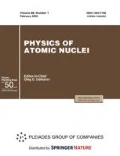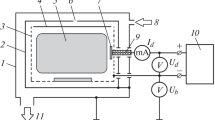Abstract
Mirrors for light transmittance will be used in more than 30 optical and laser diagnostics installed in the ITER tokamak reactor. Their reliable performance depends largely on the degradation rate of the first mirror directly facing the plasma. The fluxes of neutral atoms, mostly D, T, and Be, from the plasma are the most dangerous for the first mirror. The interaction with the high-energy atoms can lead to sputtering of the mirror surface; redeposition of beryllium sputtered from the walls of the vacuum chamber can lead to the formation of a film on the mirror. This paper gives a conservative estimate of the degradation rate of in-vessel mirrors in the equatorial channels of the H-alpha and Visible Spectroscopy diagnostics. Calculations were performed for stationary ITER operation using the Zemax OpticStudio program. The results show that the working area of the first mirror will be sputtered at a rate of no more than 100 nm/year, which is an acceptable erosion load for mirrors made of single-crystal molybdenum. Beryllium film formation is expected only at the edges of the mirror (outside the working area). Possible contamination of the working part of the mirror as a result of accidents or plasma events can be eliminated using the mirror cleaning system installed into the first mirror unit. For the other in-vessel mirrors, the estimate predicts no significant degradation owing to their location at a long distance from the plasma.








Similar content being viewed by others
REFERENCES
E. N. Andreenko, A. G. Alekseev, A. B. Kukushkin, et al., Fusion Eng. Des. 123, 825 (2017).
A. F. Bardamid, K. Yu. Vukolov, V. G. Konovalov, I. I. Orlovsky, et al., Plasma Dev. Operat. 12, 203 (2004).
I. Orlovskiy, A. Alekseev, E. Andreenko, et al., Fusion Eng. Des. 96–97, 899 (2015).
A. V. Rogov and Yu. V. Kapustin, Usp. Prikl. Fiz. 4, 240 (2016).
Yu. V. Kapustin and A. V. Rogov, Vopr. At. Nauki Tekh., Ser.: Termoyad. Sintez 42 (1), 57 (2019).
A. V. Rogov and Yu. V. Kapustin, in Proceedings of the 17th All-Russian Conference on Diagnostics of High-Temperature Plasma, Zvenigorod, June 13–17, 2017, p. 68.
V. Kotov, Nucl. Fusion 56, 106027 (2016).
V. Kotov, D. Reiter, A. Litnovsky, et al., Phys. Scr. 145, 014071 (2011).
A. Gorshkov, A. Alekseev, E. Andreenko, et al., in Proceedings of the 30th Symposium on Fusion Technology, Giardini Naxos, Italy, Sept. 16–21, 2018, P2.050.
D. K. Kogut, N. N. Trifonov, and V. A. Kurnaev, J. Nucl. Mater. 438, S731 (2013).
W. Eckstein, C. Garcia-Rosales, J. Roth, and W. Ottenberger, Plasmaphys. Report No. IPP 9/82 (Max-Plank-Inst. Plasma, 1993).
S. Moon et al., Nucl. Mater. Energy 19, 59 (2019).
A. Litnovsky et al., Nucl. Fus. 59, 066029 (2019).
J. Brooks and J. Allain, Nucl. Fusion 48, 106027 (2008).
V. Kotov, in Proceedings of the 43rd EPS Conference on Plasma Physics, Leuven, Belgium, July 4–8, 2016, P5.051.
www.eirene.de/html/surface_data.html.
T. Sugie et al., J. Nucl. Mater. B 329–333, 1481 (2004).
A. V. Rogov, Yu. V. Kapustin, A. V. Gorshkov, and S. V. Akhtyrskiy, in Proceedings of the 30th Meeting of the ITPA Diagnostics Topical Group, Novosibirsk, June 21–24, 2016.
Author information
Authors and Affiliations
Corresponding authors
Ethics declarations
The authors declare that they have no conflicts of interest.
Additional information
Translated by V. A. Alekseev
Rights and permissions
About this article
Cite this article
Andreenko, E.N., Orlovskiy, I.I., Alekseev, A.G. et al. Estimation of the Degradation Rate of the In-Vessel Mirrors for the H-Alpha and Visible Spectroscopy Diagnostics in ITER. Phys. Atom. Nuclei 83, 1083–1092 (2020). https://doi.org/10.1134/S1063778820070029
Received:
Revised:
Accepted:
Published:
Issue Date:
DOI: https://doi.org/10.1134/S1063778820070029



